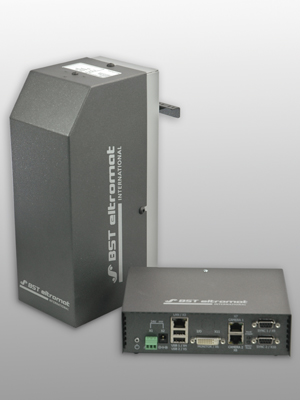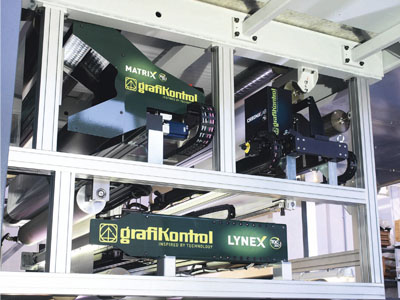Inspection on the ICON Operator Control Station
There is no room for compromise in today’s packaging market. Printed output must be of the highest quality across and throughout the roll, or converters will bear the cost of reworks or potentially even lose business. Michal Lodej looks at the inspection units which can catch defects before it is too late.
Web inspection has become a vitally important aspect of any printer’s operation, helping to identify defects during the print run, and also helping with aspects of colour management. Here an old adage rings true: if something is worth doing, then it’s worth doing properly.
With demands for zero-defect packaging production more commonplace than ever, QuadTech has built its new web inspection system from the ground up to help deliver perfect packaging print.
The company takes the view that inspection of the whole substrate width, throughout the production run at a customisable resolution is a must.
Becoming an ICON
QuadTech introduced its latest inspection system for packaging and converting printers at drupa 2016, building it upon its ICON integrated platform. ‘The result,’ said Stephan Doppelhammer, the company’s market manager for Packaging, ‘is a very powerful, very intuitive tool. We think printers will immediately understand the efficiencies to be gained, and will be excited about the value they can add to their operations.’
There are a number of innovative new features that will prove hugely beneficial to converters, among them the Golden Template: a fixed reference image that is captured at the beginning of every print run, and to which every subsequent printed copy is compared. The system tolerates web wander and stretch, detecting slow-growing defects such as register, streaking or colour changes for the full print run.
The new scalable inspection system is based upon a 64-bit software architecture, allowing a wider array of advanced algorithms to analyse the printed substrate, helping to detect defect types such as ink spots, register/colour variation, content issues, and streaks. These algorithms automatically adapt the system to changing press conditions, start-ups/restarts, splices and running speeds.
The system features the flexibility to fully customise the resolution at which the web is viewed, providing 100% image acquisition and complete inspection down to the finest detail.
A key element in the design of the product has been giving users the capability to clearly view defects when they are discovered. Consequently, it includes a new high definition wide screen user interface, which supports larger image sizes for defect analysis, while temperature-controlled LED lighting gives printers the lowest level of granularity to identify defects and prevent costly waste when viewing the substrate. The stability of this light output results in clean, high-quality inspection images. Custom lighting designs are available for applications such as standard, reflective, trans missive, and UV.
The system has an intuitive user interface that provides press operators with powerful new capabilities, such as masks and multiple defect sensitivities, and a live, colour-coded roll map, which allows operators to quickly identify different types of defects, and make fast decisions about the severity of a defect and how to deal with it.
Feel the power
BST eltromat International, recently presented its technology portfolio at this year’s All4Pack held 12-15 November at the Paris Nord Villepinte. The company focused on quality assurance in the production of packaging, labels and printed electronics. The presentations featured the product segments of web guiding, 100% inspection, web video inspection, colour measurement and control, as well as layer thickness and basis weight measurement.

The POWERScope 5000
The company’s flagship product was the POWERScope 5000. The new digital video inspection system offers greatly improved image quality compared to previous solutions. As a result, machine operators can detect irregularities faster. As well as the POWERScope 5000, the TubeScan eagleview, developed in cooperation with partner Nyquist Systems, was also on show. The system combines cameras for 100% print inspection and also for video web inspection. The machine operators have the possibility to use the 100% print inspection as well as the other cameras for a detailed zoom image.
In regard to its web guiding sensors, the CLS Pro 600 digital line and contrast sensor was also presented. The colour sensors of the CLS Pro 600 sensor provide precise, non-contact scanning of lines, and also of print or web edges. The combination of high scan rate and high-resolution CCD colour line chip guarantees precise guiding of the webs, even when dealing with broken lines or contrasts.
The company’s range at All4Pack was completed by the sensor for layer thickness and basis weight measurement from its subsidiary BST ProControl. Its PC16S-wave transmission sensor, works without ionising electromagnetic waves. Polymer-based monofilms can be measured particularly accurately and quickly in this way. This sensor can be used without requiring any national or international approval procedures at all and thanks to its EMC properties, it ensures interference-free operation, which complies with all statutory regulations, and is suitable for cost-efficient use in standard applications.
The company can compile tailor-made configurations based on elements from its comprehensive product range, which is designed with a modular structure and offers customers a choice between eco versions, standard systems and high-end solutions. If necessary, the configurations can be adapted to suit individual customers.
Martin Betting, managing director of BST eltromat France, said, ‘In all product segments, we have experts who competently support our customers from start to finish – from the initial enquiry, all the way to final training certification – and can specifically consider their individual requirements.’
Taking control
TQC-360 is the newest modular platform for Grafikontrol’s products. It has been developed to give printers a complete solution for quality assurance. With the TQC-360 concept, the company offers a full range of quality control to the printing and converting industry through production, application, and processes and services.

Progrex system
Another of the company’s products is Progrex, which is an integrated solution designed for high quality control. The combination of the different technologies, linked to image processing algorithms, provides a complete and simple instrument to support the operator. The solution combines two high end technologies in one single system; Lynex for the 100% inspection of the entire web with full print repeat display, and Matrix area camera for an accurate visualisation of the details
These parallel functions allow the user to control the printing process from a single interface. The interactive functions between the two systems make Progrex the most ergonomic inspection equipment on the market today.
Smart integration
The software offered with Matrix and Lynex are integrated for a complete quality assurance package. Intuitive and modern graphics are combined with the touch screen reduce the time for system set up to only a few seconds.
Print inspection, pre-register, bar-code verification, ∆ colour monitoring, and PDF to live master comparison, all are integrated into the system framework and can be immediately activated from a single operator screen.
For further down the production line Grafikontrol has Procheck, an innovative waste management system. It uses the information gathered during the print inspection (roll maps) and transfers it to the next converting process (slitting or doctoring) where the waste is removed. The traceability of the defects is easy and accurate thanks to a special high speed inkjet marking system (Procheck-mark) that generates and prints a variable ‘synch-code’ on the edge of the substrate during the printing process. The synch-code is periodically printed and contains the information relative to job number, roll number and roll length. Each defect detected by the 100% inspection system is then synchronised to the closest synch-code. When the printed roll is moved to the slitting section, during the unwinding, a dedicated scanner (Procheck reader) reads the synch-codes along with the data from the roll map. The system connects to the controls of the slitter and the software stops it at the defect location for its removal. To help the operator a defect’s image sequence is displayed on the operator screen during the process. The information for each roll can be edited by the quality control personnel, before sending it to the final process. That way, only the undesired and verified defects will be quickly removed.
Read the rest of the FlexoTech December issue here.





